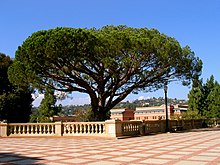Terrace (building)
– **Ground Terraces**
– Used for leisure activities like sitting, strolling, or resting
– Often in front of monumental buildings reached by grand staircases
– Supported by embankments or solid foundations
– Platforms supported by columns, open to the sky, may or may not be paved
– Found in various architectural styles globally
– **History and Examples of Terraces**
– Agricultural terracing dates back to prehistoric times
– Early architectural terracing examples in Middle East and Greece
– Roman Empire extensively used terraces in front of monumental structures
– Traditional Thai homes incorporate central terraces
– Architectural theories on the role and design of terraces vary widely
– **Roof Terraces**
– Flat roof areas used for social activities are also considered terraces
– Venice’s rooftop terrace, altana, developed around 1500 CE
– Altana initially used for drying laundry, now for social gatherings
– **Related Concepts**
– Balcony
– Band stand
– Deck
– Gazebo
– Hardscape
– **References**
– Books on historic architecture, archaeological studies, and architectural theories
– Examples of terracing in different regions and historical periods
A terrace is an external, raised, open, flat area in either a landscape (such as a park or garden) near a building, or as a roof terrace on a flat roof.

